China - Table of Contents............. Chinese Architecture Dictionary .......... Architecture Around the World
Shanghai Museum - Table of Contents
Ming Dynasty Furniture - Shanghai Museum
People's Square, Shanghai, China
Shanghai Museum - Official Website
2013 photos
|
Ming Dynasty Furniture
Ming furniture is treasured for its precious wood, comfortable design, simple decoration and superb craftsmanship. The texture of wood was fully used to reveal natural beauty. Simple design had nothing to do with cheapness; red sandalwood and scented rosewood represented essential value. Handwritings and paintings by well-known calligraphers and painters were engraved in desks and chairs Simple structure and minimal decoration set off the natural beauty of the wood. This meaningful simplicity was achieved without sacrificing comfort. Scientific protection for bodily form was reflected in details such as curves, lines, height, and size. Chinese traditional culture emphasizes the positive interplay between nature and human beings. Applying ideas from Zen and Tao, scholars and craftsmen devoted their wisdom and passion to reflecting this golden rule in furniture. - TravelChinaGuide.com (online Jan. 2014)
|
|
Ming Dynasty Furniture
Often completely unornamented (although the complete range of
decorative degree does exist), they obtain their stunning effect
principally through their perfection of line, and their magnificent
hardwood material (left on view through a clear finish, not covered in
lacquer as with so much Chinese furniture, then and especially later). Joinery In addition, their joinery represents the most elaborate development of the miter, mortise and tenon ever developed anywhere. They hold pieces together without the use of any glue, enabling the pieces to be disassembled at will, important in a setting where the owners (mostly mandarins) needed to relocate on a regular basis, and where most transport was via animal. Although simple in the extreme on the surface (one explicit goal of Chinese joinery), inside these joints are extremely complex. A classic example is the mitred triple-tenon three-way corner joint. - J. Noel Chiappa (online Jan. 2014)
|
|
Ming Dynasty Furniture
Ming Dynasty furniture is usually simple, if somewhat rustic, in
design, projecting an image of sturdiness combined with simple elegance.The Ming Dynasty is considered, in hindsight, the golden era in the development of ancient Chinese furniture. This is partly due to the abundance, as yet, of the hard woods used to make furniture during the period, hard woods such as Chinese pear wood and its later substitute, sandalwood; the increasing demand for furniture had, toward the end of the Ming Dynasty, seriously depleted the stocks of the Chinese pear tree, which was of course also prized for its fruit. But the later recognition of the Ming Dynasty as the golden era of Chinese furniture was also partly due to two other features of the furniture of this period, namely, the development, on the one hand, of mortise and tenon joinery (think of the way that two pieces of a jigsaw puzzle fit together) – which required no nails, screws or other metal joining devices – and, on the other hand, the dovetailing of design to the intended practical use of the article of furniture in question; in other words, Ming Dynasty period furniture was not fancifully designed for the sake of design itself, meaning that design was not divorced from function. In this same spirit, Ming Dynasty period furniture was neither lacquered, delicately designed, nor embellished with ornate carvings, but was deliberately designed to be simple and sedate, where the natural color and grain of the wood was allowed to speak for itself, as it were. Typical articles of furniture made of Chinese pear wood were large-surface items such as tables, chairs and commodes. - China Highlights (online Jan. 2014)
|
|
Why is the nail prohibited in rosewood furniture?
Ever since the Hemudu Neolithic Age as early as more than 7000 years ago, ancestors of the Chinese people had began to use the mortise and tenon joint. As one of the unique and special techniques in China, the mortise and tenon structure has a long history and is the core of the Chinese-style furniture, which is also called the traditional furniture. The furniture with mortise and tenon structure is tougher and more durable than that connected with iron nails. First of all, the mortise and tenon structure uses both mortise and tenon with elaborated combinations of different parts of the furniture, large and small, high and low, long and short to effectively restrict the twist of them in different directions, which might never be achieved with iron nail connection. Secondly, metal rusts and oxidizes easily, while the real mahogany furniture may be used for hundreds or thousands of years. Lots of Ming-style furniture with a history of several hundred years is still as hard as it was in its woodiness, though a little bit old over the times, whereas the furniture with iron nail connection may keep fine woodiness, but may fall apart easily because of the rust, wearing and aging of its metal connection. Furniture with mortise and tenon structure is easy for maintenance. During the several hundred years’ use of the mahogany furniture, it is easy and convenient to change any stretcher when it is broken, while it is not the case for furniture with iron nail connection. The iron nails may tear the furniture into pieces during the maintenance. The mahogany is hard in woodiness, while the iron nail is always wedged or drilled into the wood, which may flerry the wood. That is why iron nails are never used in mahogany furniture. - Cultural China (online Jan. 2014)
|
Huanghuali wood: from the Chinese tree Dalbergia odorifera - or fragrant rosewood
- which is often used in Chinese woodworking. This valuable wood
is known in China as huali. Most of the higher quality furnitures from
the Ming and early Qing dynasties were made of huali, now known as
huanghuali.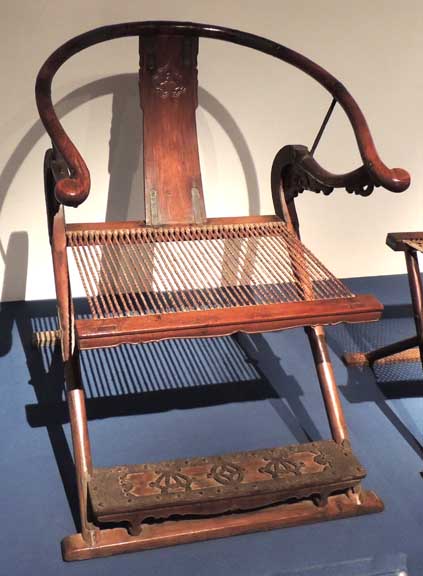 Example #1 - Folding armchair with curved rest Huanghuali wood "Jiaoy armchair with a round
back. This belongs to the highest grade of jiaoyi and was for the
exclusive use of members of the imperial family. When folded, such
chairs could be carried on a journey, and this is why they were also
known as travelling chairs.
When the emperor went on a hunting excursion, his bodyguard would
follow in tow with the folding chairs on their shoulders. Thus jiaoyi
was also known as Hunters chair. - Cultural China (online Jan. 2014)
The ancient Chinese knelt or sat cross-legged upon woven mats
surrounded by various furnishings including low tables, screens, and
armrests. Developments toward high seating were influenced by foreign customs and the migration of Buddhism.
Two details below: 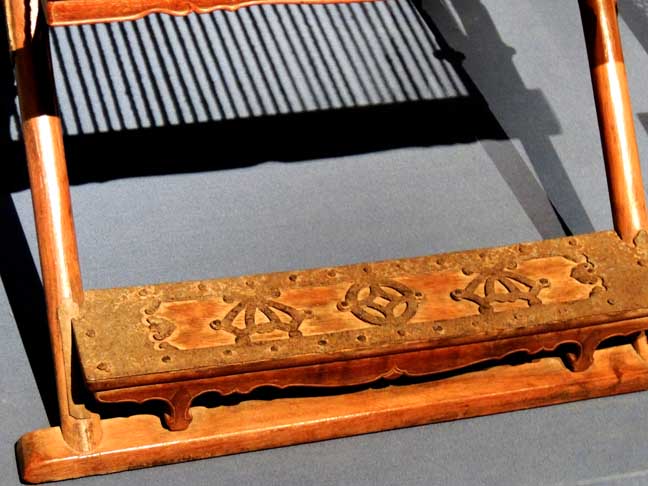 Example #1 - first detail 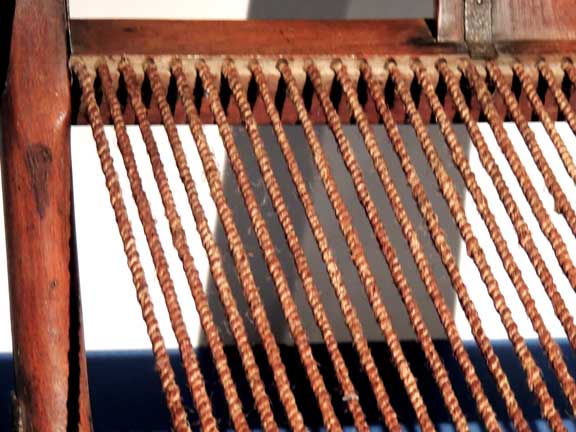 Example #1 - second detail 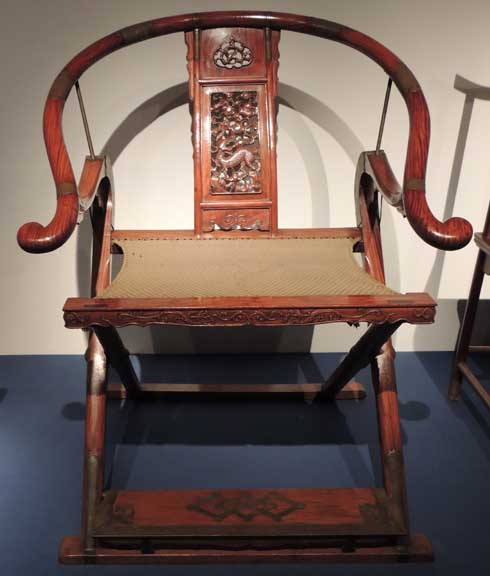 Example #2 - Carved folding chair Huanghuali wood The furniture in Ming dynasty can be classified into five categories according to the function: table & case category, bed & couch category, chair & stool category, frame & shelf category and screen category. Detail below: 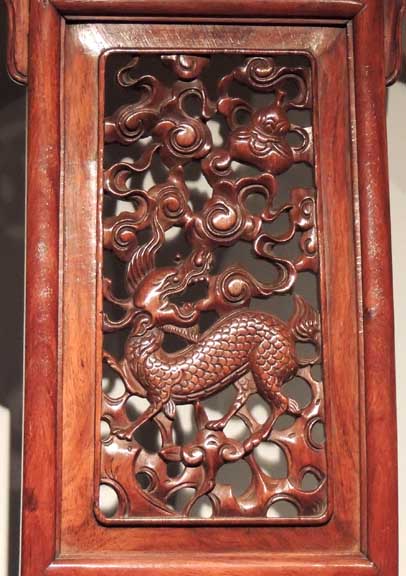 Example #2 - Detail Dragon 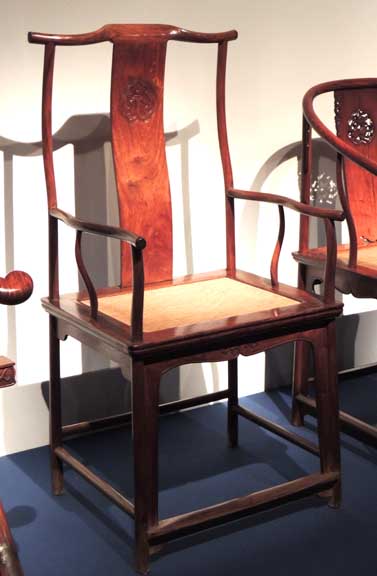 Example #3 - Official's Hat Armchair with Four Protruding Ends "Its name comes from
its long top rail and armrests. It is made of best-quality timber and
its top rail, posts, back splat, armrests, side posts and gooseneck
extensions are of a very slender shape. Usually placed in living rooms
and sometimes in studies and bedrooms, the official's hat armchair got
full developments from the Tang and Song dynasties onward and became
very popular during the Ming Dynasty." - Cultural China (online Jan. 2014)
 Example #4 Note center upper splat panel - Detail below: 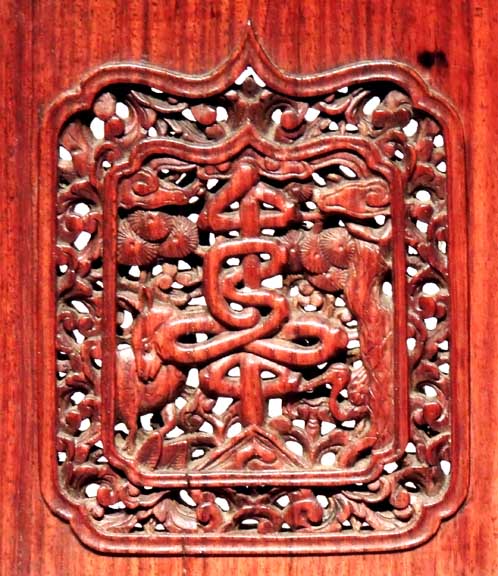 Example #4: Center upper splat panel detail 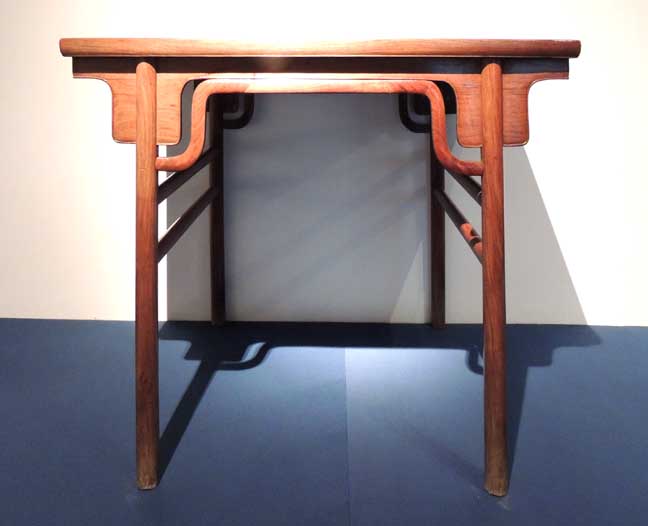 Example #5 Apron with rounded rectangular spandrels ... Rounded twin stretchers The furniture in Ming dynasty can be classified into five categories according to the function: table & case category, bed & couch category, chair & stool category, frame & shelf category and screen category. 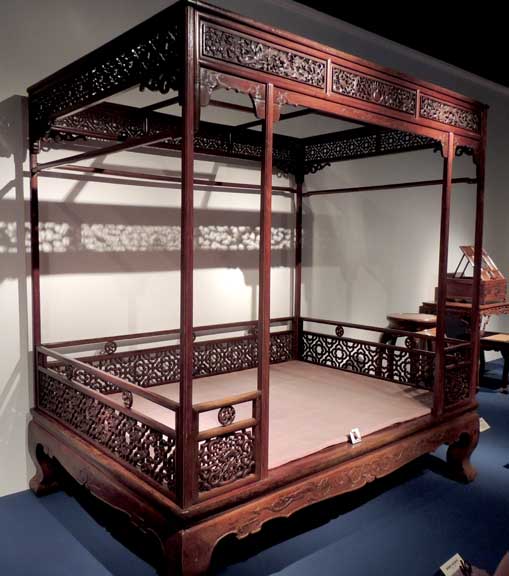 Example #6 - Six post canopy bed with railings. "This large bed was made of Huanghuali wood. The front panel on the top
is decorated with pearl and flame patterns in openwork carving. As for
the panels on either side, they are decorated with the designs of a
dragon amongst clouds. Obviously, it is a group of pictures based on
traditional themes, including 'Two Phoenix Flying toward the Sun' and
'Two Dragons Playing with a Pearl'. In the central board of the front
panel, there is the design of 'Kylin (Chinese Unicorn) Sending in
Babies' in openwork carving. All of these exquisite decorations are in
pursuit of happiness and good luck." - Cultural China (online Jan. 2014)
5 details below: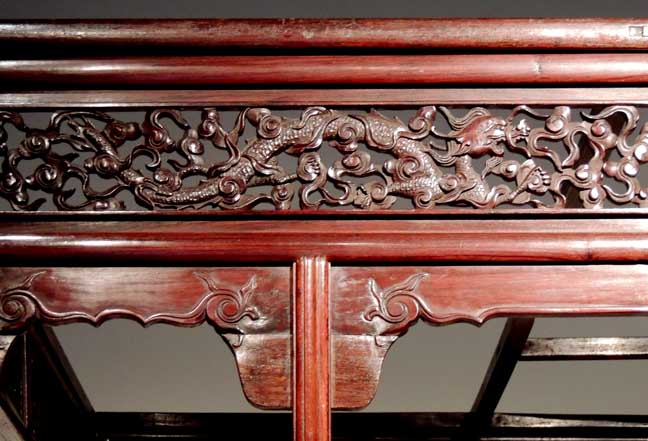 Example #6 - Six post canopy bed with railings. 1st of five details. Note dragon . 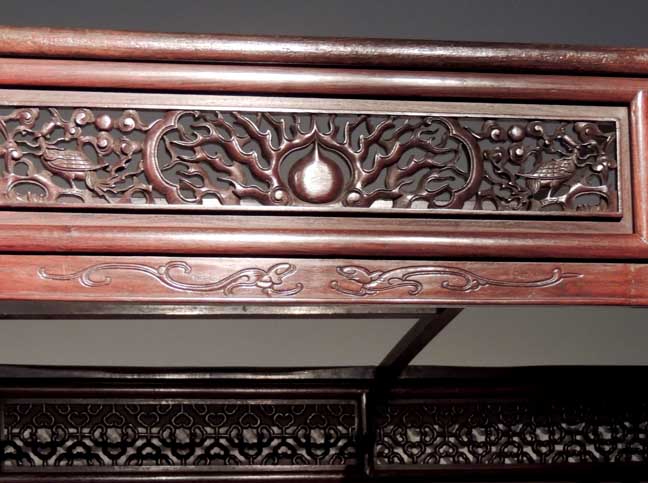 Example #6 - Six post canopy bed with railings. 2nd of five details. 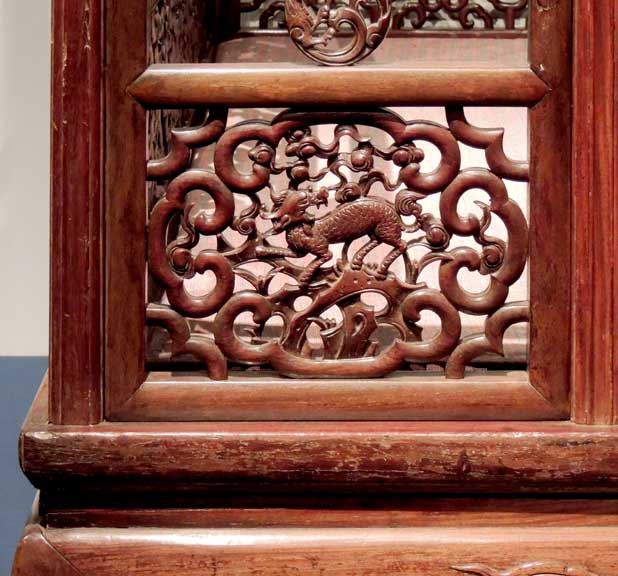 Example #6 - Six post canopy bed with railings. 3rd of five details - Huanghuali wood dragon carving 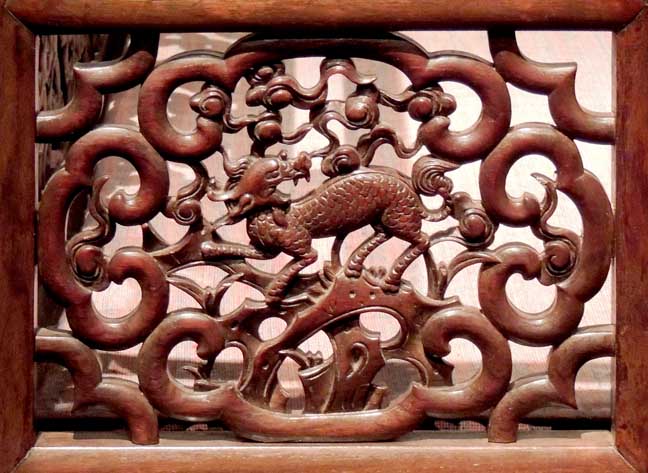 Example #6 - Six post canopy bed with railings. 4th of five details - Huanghuali wood dragon carving. 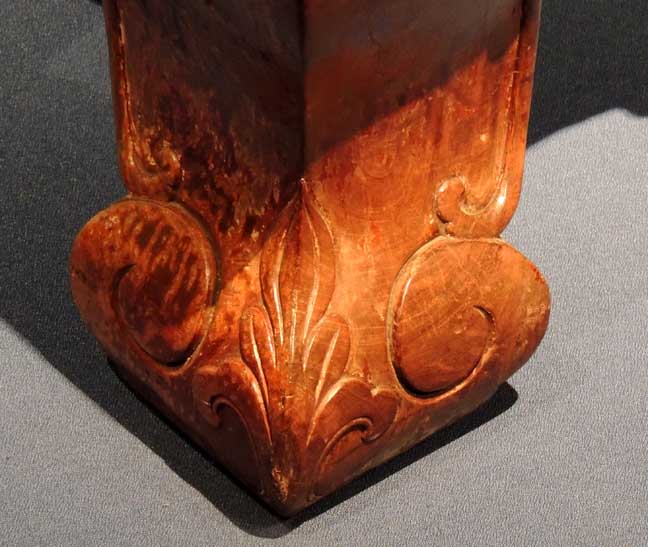 Example #6 - Six post canopy bed with railings. 5th of five details. 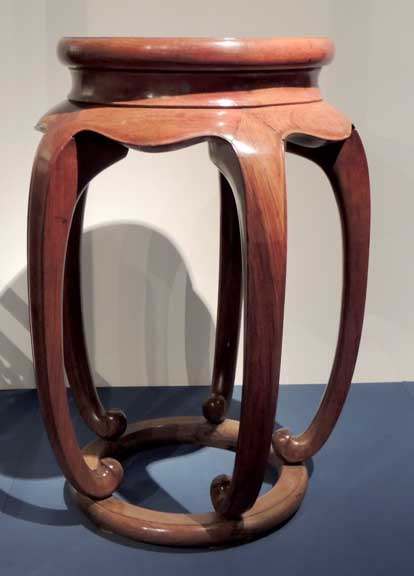 Example #6 - Round drum stool 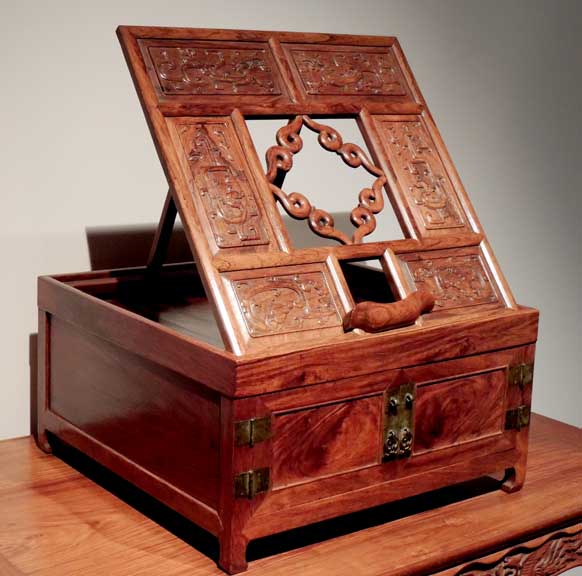 Example #7 The furniture in Ming dynasty can be classified into five categories according to the function: table & case category, bed & couch category, chair & stool category, frame & shelf category and screen category. 4 details below: 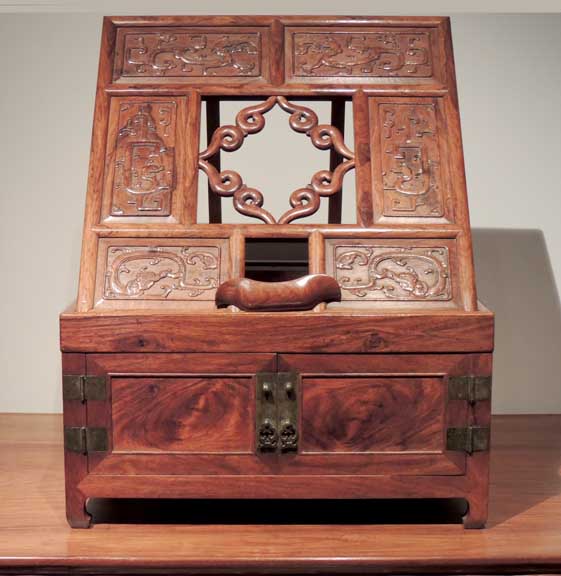 Example #7 - 1st of four details  Example #7 - 2nd of four details: dragon  Example #7 - 3rd of four details: dragon at left 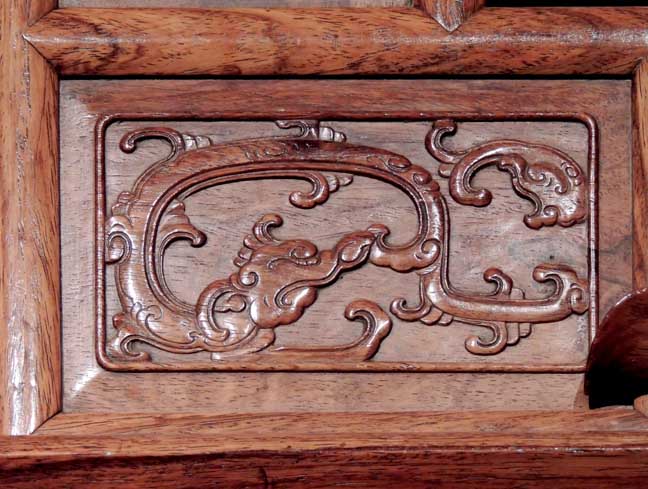 Example #7 - 4th of four details: dragon  Example #8 - Luohan Bed with carpenter's square motif. The carpenter's square is an emblem of a just and upright life, being also the symbol of prosperity. The furniture in Ming dynasty can be classified into five categories according to the function: table & case category, bed & couch category, chair & stool category, frame & shelf category and screen category. "Although the use was similar to
the daybed, the couch bed (chuang, luohan chuang) is distinguished by
railings, which render it as a more formal piece of furniture. The
development of railings may be related with the early placement of
screen panels around the back and sides of the platform, which enhanced
the sitter as well as provided privacy and protection from drafts. This
practice gradually gave rise to decorative railings attached to the
seat frame of the platform. By the Ming dynasty, the box-style platform
had developed into the more sophisticated open-structured, corner-leg
form." - Classical Chinese Furniture (online Jan. 2014) Detail below: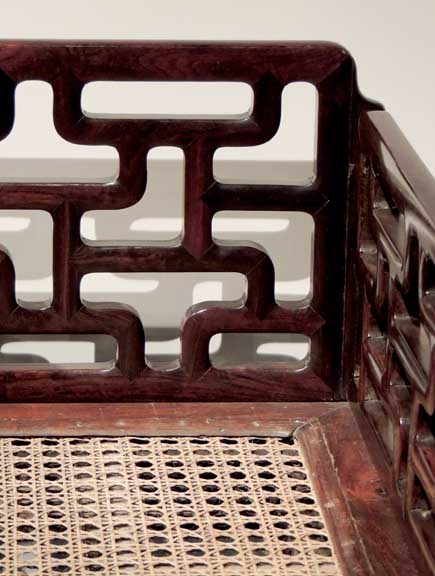 Example #8 - Detail: fretwork 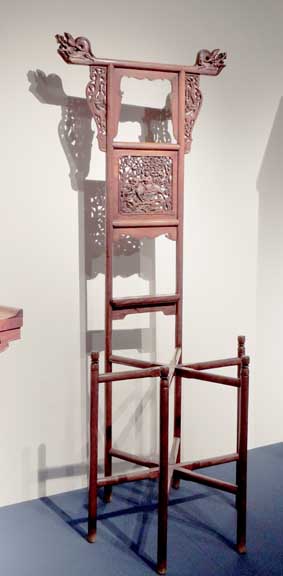 Example #9 - Washbasin stand with a towel rack. Cf., another Chinese wash stand. Note center carved panel - detail below: 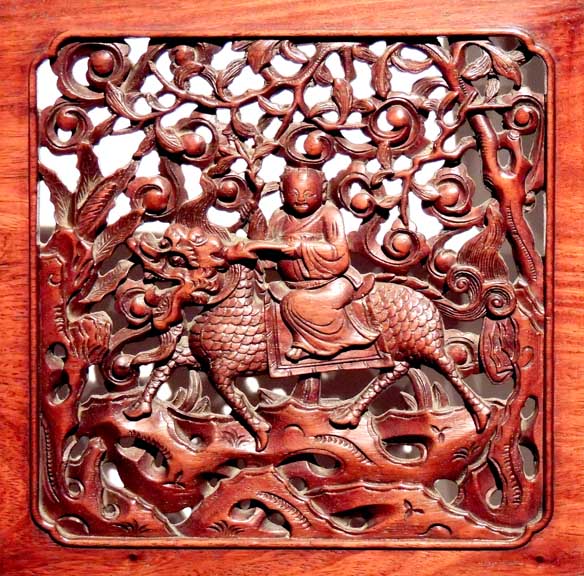 Example #9 - Washbasin stand with a towel rack. Detail: man riding dragon 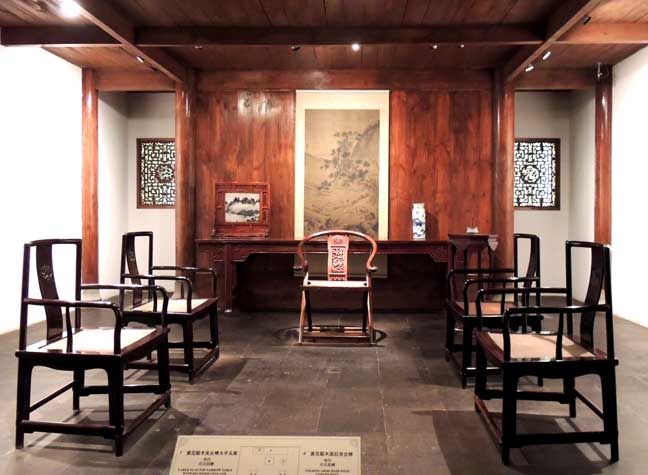 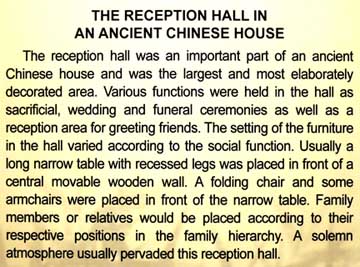 |

